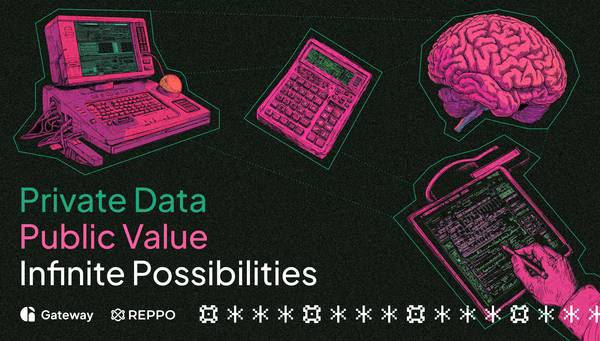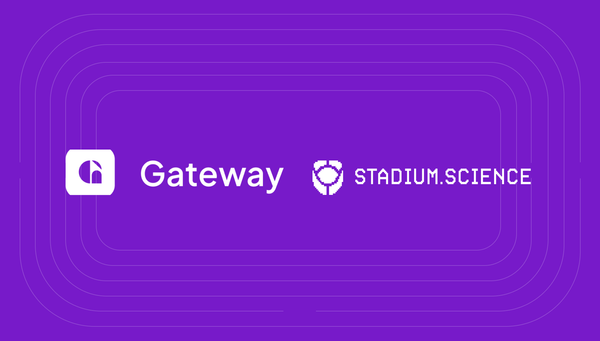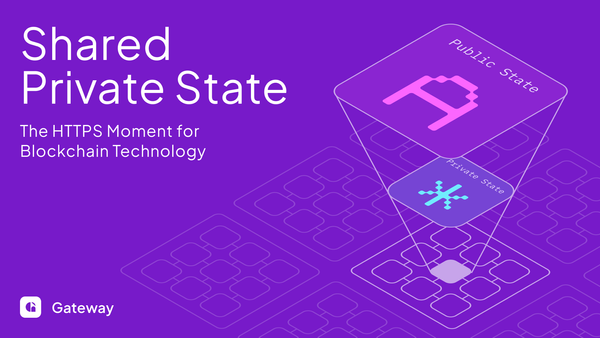Introducing Gateway: The Decentralized Private Computer
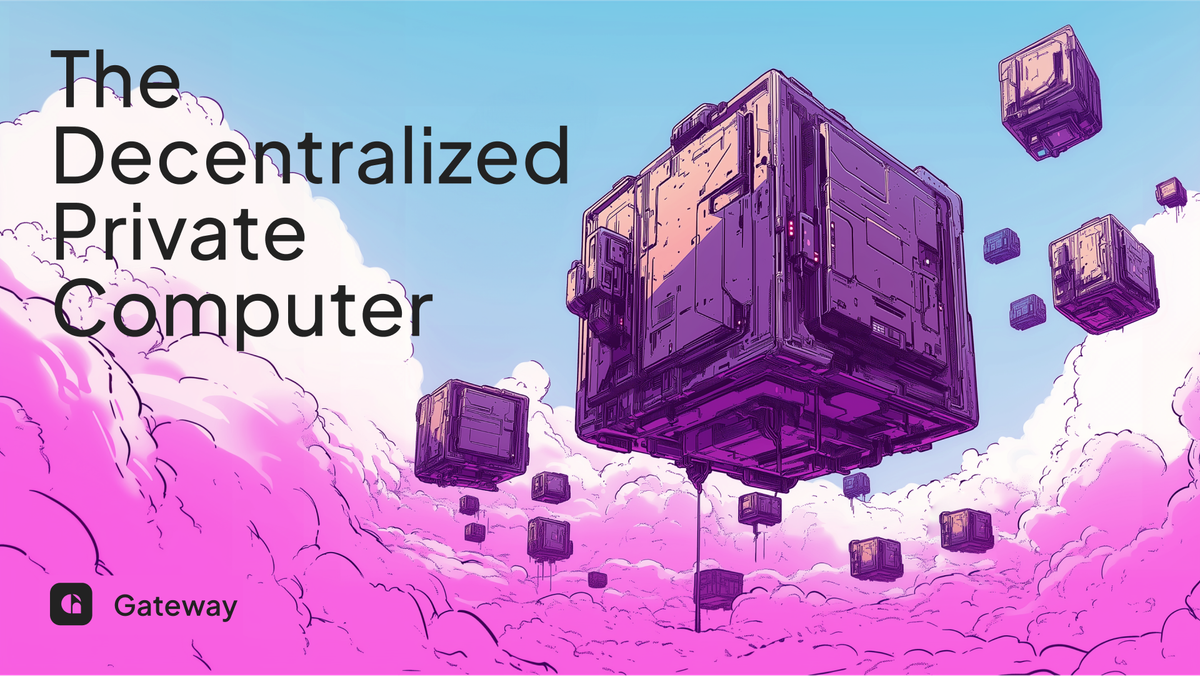
Abstract
The web’s original vision promised a decentralized network of unrestricted information and innovation. Today, we stand at the threshold of realizing its full potential, yet face a significant challenge: the inability to utilize valuable, sensitive data across organizational boundaries.
In our data-rich era, we face a paradox: despite generating vast amounts of information, crucial insights remain trapped in silos. This isolation hinders innovation and prevents solutions to global challenges. The internet's promise of a knowledge network driving human progress remains unfulfilled.
This is the challenge Gateway solves. It is an opportunity to reshape nearly every sector of our economy, and empower humans to take back sovereignty over their most valuable asset. This is why we built Gateway Protocol, the decentralized private computer.
The Trust Dilemma
At the heart of this challenge lies a critical issue: trust. Data, unlike physical goods or digital assets, possesses a distinctive property: once shared, the original "owner" often loses their exclusive advantage. Traditional assets can be lent, traded, or sold while retaining their scarcity and value, but data's value lies in its exclusivity and the insights it provides. This fundamental difference creates a significant barrier to collaboration and open exchange.
Consider a world where we could predict and prevent heart attacks with unprecedented accuracy, saving millions of lives annually. This vision is within reach - the data to achieve it exists, scattered across healthcare providers, fitness apps, and genetic testing companies. Each holds a piece of the puzzle: medical histories, real-time fitness data, genetic predispositions, and lifestyle information. Combined, this data could revolutionize preventive healthcare.
Yet, a critical barrier stands in the way: the risks associated with sharing. Companies fear losing their competitive edge, facing privacy breaches, or seeing their data misused. As a result, life-saving innovations remain locked away in corporate vaults.
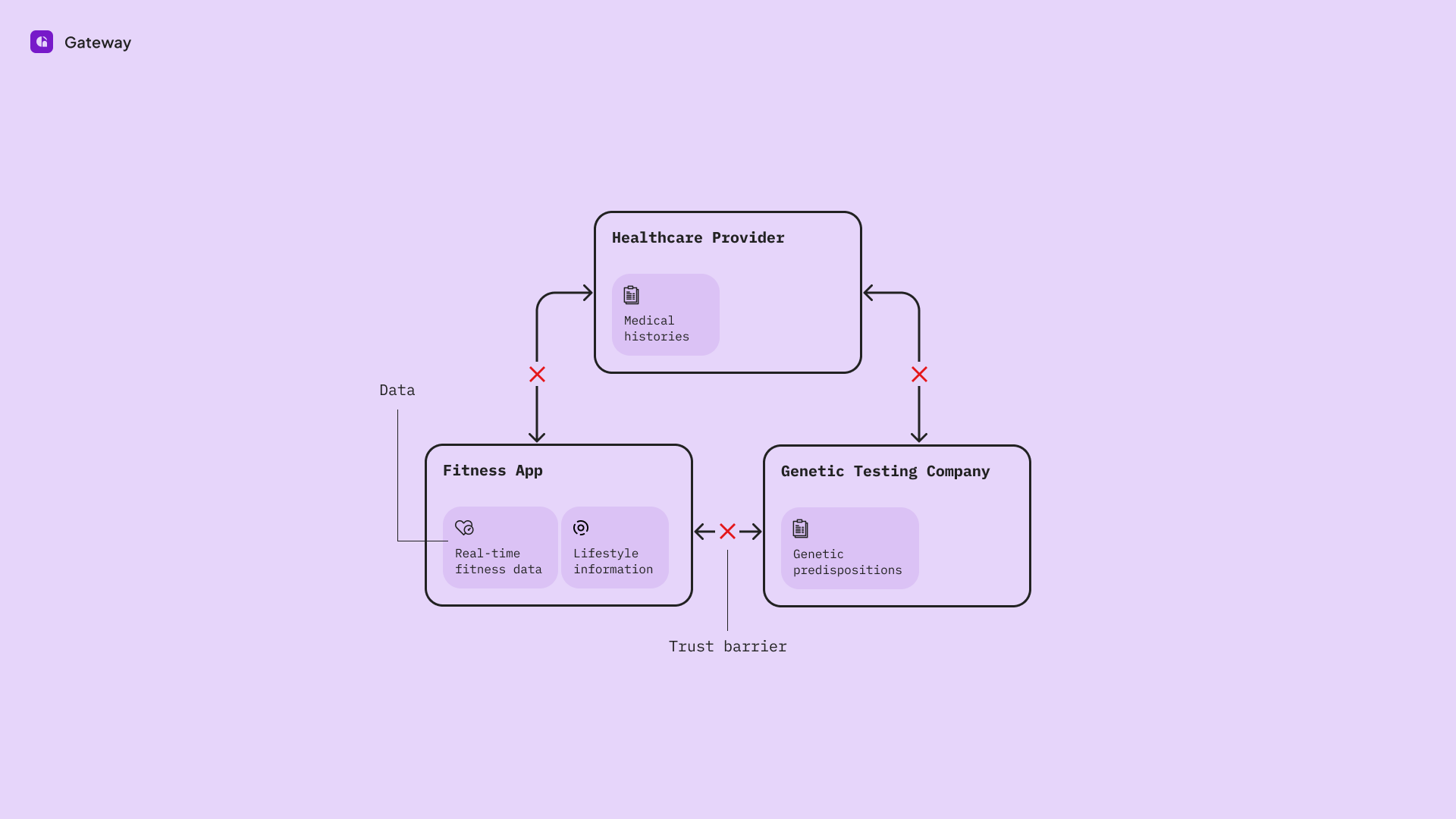
From finance to energy, education to entertainment, the story repeats. The promise of data-driven innovation collides with the realities of competition and privacy concerns, creating a stalemate that prevents progress across the entire economy.
To unlock the true potential of our collective data and realize the web's original ethos, we need a new paradigm: a sovereign data infrastructure that leverages both cryptographic principles and advanced privacy techniques.
Requirements of a Sovereign Data Infrastructure
The sovereign data infrastructure of the new web will need to have 2 fundamental requirements.
First, the internet needs a global, interoperable data lake. There is an exponential growth of data generation especially with the increasing power of AI and machine learning. This abundance creates a paradox: more data than ever, yet much of it remains trapped in incompatible silos, limiting its potential impact. A global data lake would serve as a standardized repository where diverse datasets can coexist and be discovered. By creating a common language and structure for data, such an infrastructure would enable organizations of all sizes to contribute to and benefit from a vast pool of knowledge.
Second, the internet needs a privacy-preserving computation layer. While a global data lake makes information discoverable, we must address how to use this shared data securely, especially when coordinating information from multiple parties. A privacy-preserving computation layer would allow analysis of sensitive information from multiple sources without exposing the underlying data of any party. As AI and machine learning advance, we need to ensure we can leverage these powerful tools across the global data lake without infringing on privacy rights, opening new frontiers in data-driven innovation.
Gateway Protocol: The Gateway Into a New Web
The Gateway Protocol aims to be the singular protocol for all of humanity’s most valuable data. The protocol will democratize and untether all data across the web, revolutionizing how information is processed and used.

The Gateway Data Lake
One of the core functions of the protocol is enabling storage and access of any information from anywhere on the web. This transforms the entire internet into a vast, interoperable data lake.
- Encrypted Data Vaults: The protocol enables encrypted storage for any dataset and is fault tolerant by default.
- Universal Data Formats: Every piece of information in the protocol follows a standardized data format, enabling every other “packets” of private data to be fully compatible with one another.
- Granular Access Control: The data lake leverages privacy enhancing tech like proxy re-encryption to enable secure access management.
This global data lake forms the foundation upon which different parties can utilize and compute over distributed, sensitive data.
Gateway Private Compute
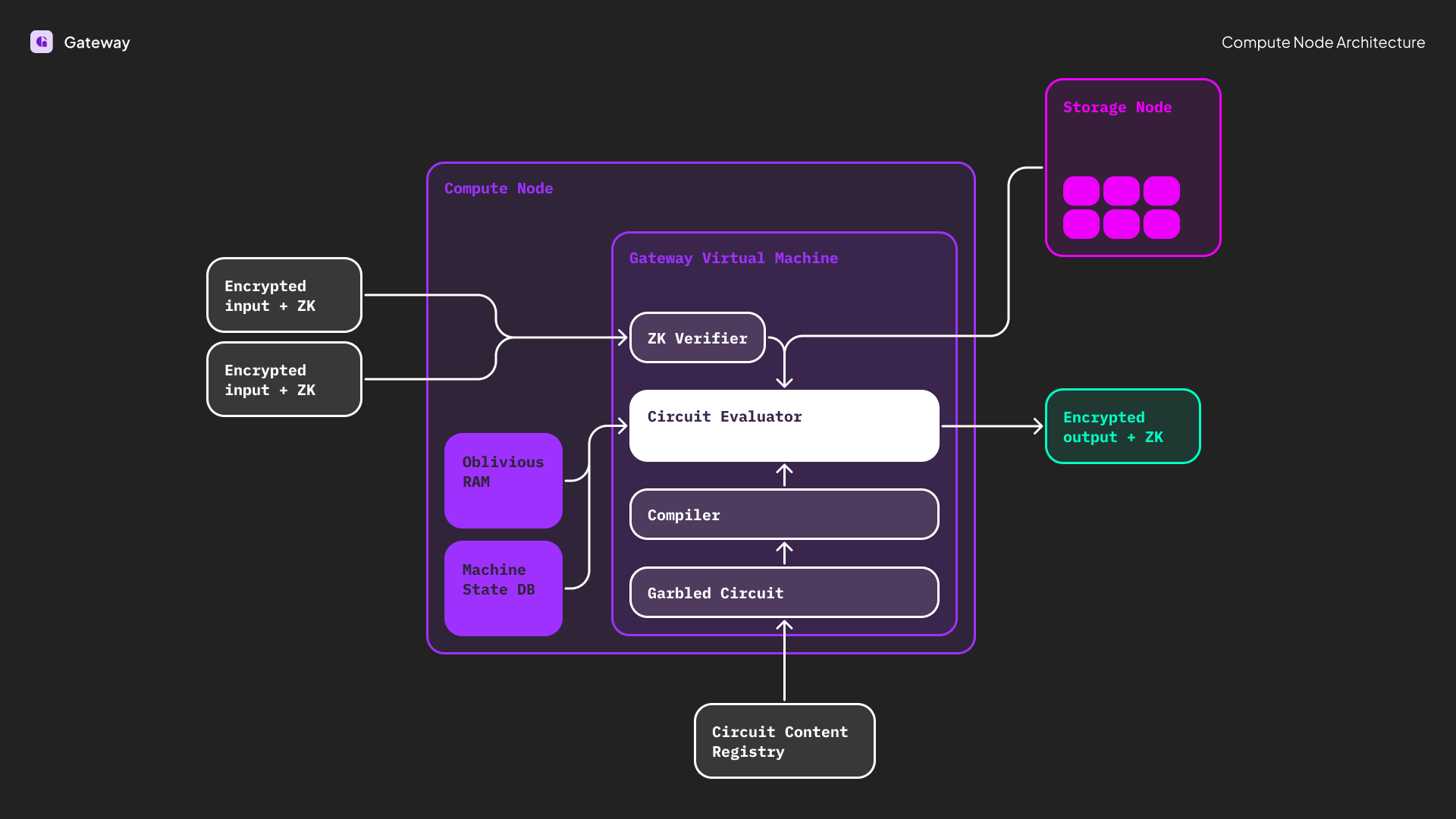
Gateway Virtual Machine (GVM)
At the heart of the Gateway ecosystem lies the Gateway Virtual Machine (GVM), a Turing-complete virtual machine designed to execute arbitrary functions over any set of private inputs. The GVM serves as the foundation for enabling secure, verifiable, and private computation.
Key features of the GVM include:
- Turing Completeness: The GVM can compute any algorithm, making it infinitely flexible and adaptable to various computational needs.
- End-to-End Encrypted Compute: Utilizing garbled circuits and other PETs as a hyper-performant cryptographic CPU, the GVM performs calculations on encrypted data without decryption, ensuring data remains protected throughout the entire computation process.
- Verifiable Compute: All computations performed by the GVM are verifiable through zk SNARKS, allowing parties to confirm the correctness of results without revealing the underlying data.

Verifiable Private Compute
Leveraging the powerful capabilities of the GVM, the Gateway Protocol enables private verifiable compute over "packet(s)" of data stored in the Gateway Data Lake. This approach decouples data from traditional location constraints and trust requirements, allowing for secure, trustless computation anywhere.
The Gateway Protocol offers several key features:
- Universal Accessibility: Any entity, from individual developers to large enterprises, can access powerful private computation resources.
- Cross-Domain Applications: Solutions can be built that span traditional and decentralized systems, opening up new possibilities for data utilization and service creation.
- Scalable and Resilient: The protocol's decentralized architecture ensures both scalability, as computational power grows with each new node, and resilience, eliminating single points of failure and enhancing overall system reliability.
By leveraging the GVM's novel cryptographic primitives, the Gateway Protocol enables verifiable untethered data processing. This approach allows for secure computation without compromising data privacy or integrity, forcing us to rethink how we utilize data across various domains and applications.
New Economies in the New Web
Just as blockchains like Solana and Ethereum promised to revolutionize industries through decentralization and transparency, the Gateway Protocol aims to unlock a new wave of economic opportunities and applications by solving a fundamental challenge: general programmability over private data.
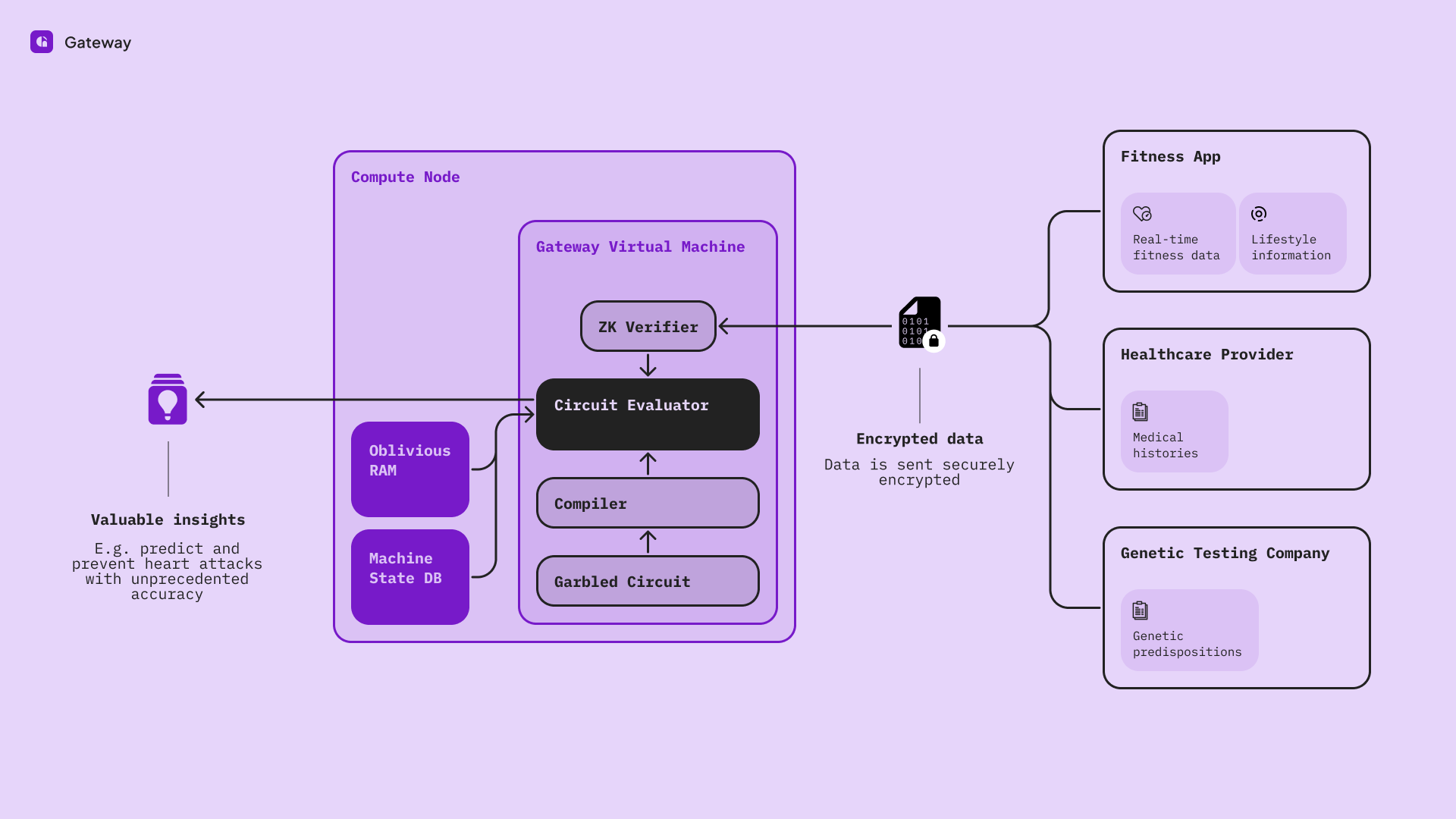
Gateway Protocol opens doors to collaborative ecosystems that were previously impossible. For instance, in retail, companies could pool purchase data across every segment, personalizing shopping experiences without compromising individual privacy. In finance, we could see the rise of truly global, privacy-preserving credit scoring systems, expanding access to financial services for millions. The whitespace for design is restricted only by the data available on the web.

Immediately, Gateway’s impact is particularly transformative. It addresses one of blockchain's most significant limitations for builders: the handling of private data. This breakthrough unlocks a new realm of web3 possibilities, enabling consumer apps that offer personalized experiences without compromising privacy, secure DePIN data exchanges, facilitates zero-knowledge identity systems, and even enables decentralized machine learning on sensitive data.
Gateway unlocks programmable cryptography as a complementary force to blockchains like Solana, dramatically accelerating web3 adoption. By enabling interoperability between web2 and web3 without mandating blockchain integration, it allows traditional enterprises to explore decentralized capabilities while leveraging existing infrastructure. As programmable cryptography becomes a universal tool for innovation, the distinction between web2 and web3 companies blurs, fostering a new era of hybrid applications that combine the strengths of both paradigms.
By offering a solution to the privacy-transparency paradox, the Gateway Protocol lays the groundwork for a new digital economy. One where data can be utilized to its fullest potential without sacrificing privacy or security. This opens up possibilities for new business models, services, and economies that we've only begun to imagine.

